Establishing Correlation between Cruise Ship Activities and Ambient PM Concentrations in the Kotor Bay Area Using a Low-Cost Sensor Network
Abstract
1. Introduction
2. Methodology
2.1. Cruise Ship and Measurement Locations in the Kotor Bay Area
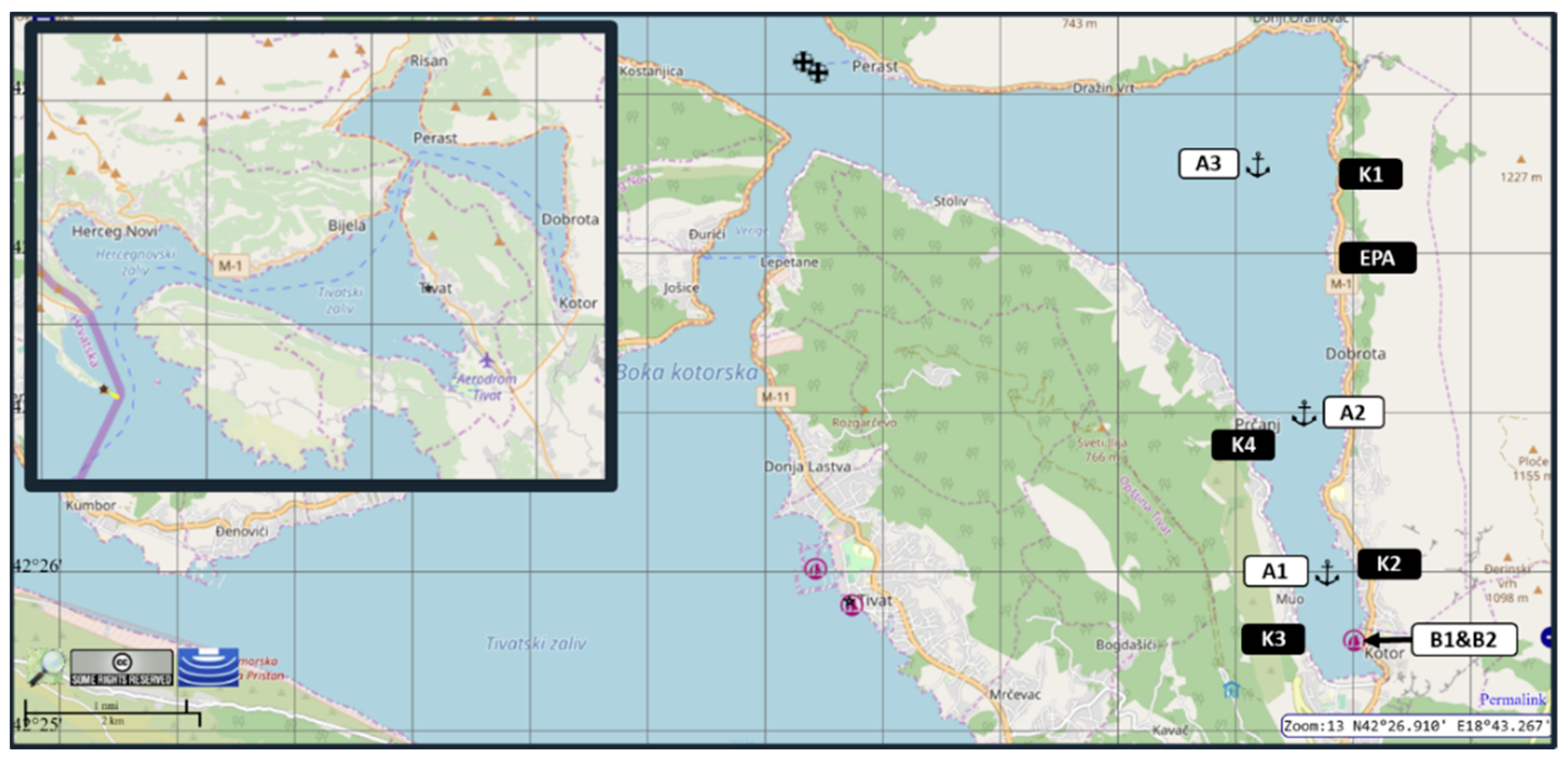
2.2. Measurement Instrumentation
2.3. Methodology for Quantification of Pollutant Emission and Cruise Ship Data
- E—emission over a complete trip (tonnes),
- P—engine nominal power (kW),
- LF—engine load factor (%),
- EF—emission factor (kg/kW),
- T—time (h),
- e—engine category,
- i—pollutant,
- j—engine type,
- m—fuel type,
- p—the different navigation mode (cruising, hoteling, maneuvering).
- (a)
- approaching and berthing or/and anchoring in ports;
- (b)
- hoteling;
- (c)
- departing from the ports;
- (d)
- cruising.
3. Results and Discussion
3.1. PM Data Validation
3.2. Temporal Variation of PM Concentration Data in Kotor Bay
3.3. Estimation of Total Emission of PM from Cruise Ships in Kotor Bay
3.4. Correlation of PM Ambient Concentration with Cruise Ship Activities in Kotor Bay
4. Conclusions
Author Contributions
Funding
Institutional Review Board Statement
Informed Consent Statement
Data Availability Statement
Acknowledgments
Conflicts of Interest
References
- Viana, M.; Hammingh, P.; Colette, A.; Querol, X.; Degraeuwe, B.; De Vlieger, I.; Van Aardenne, J. Impact of maritime transport emissions on coastal air quality in Europe. Atmos. Environ. 2014, 90, 96–105. [Google Scholar] [CrossRef]
- Tzannatos, E. Ship emissions and their externalities for the port of Piraeus–Greece. Atmos. Environ. 2010, 44, 400–407. [Google Scholar] [CrossRef]
- Hulskotte, J.; Van der Gon, H.D. Fuel consumption and associated emissions from seagoing ships at berth derived from an on-board survey. Atmos. Environ. 2010, 44, 1229–1236. [Google Scholar] [CrossRef]
- Cullinane, K.; Cullinane, S. Atmospheric Emissions from Shipping: The Need for Regulation and Approaches to Compliance. Transp. Rev. 2013, 33, 377–401. [Google Scholar] [CrossRef]
- Corbett, J.J.; Winebrake, J.J.; Green, E.H.; Kasibhatla, P.; Eyring, V.; Lauer, A. Mortality from Ship Emissions: A Global Assessment. Environ. Sci. Technol. 2007, 41, 8512–8518. [Google Scholar] [CrossRef] [PubMed]
- Sofiev, M.; Winebrake, J.J.; Johansson, L.; Carr, E.; Prank, M.; Soares, J.; Vira, J.; Kouznetsov, R.; Jalkanen, J.-P.; Corbett, J.J. Cleaner fuels for ships provide public health benefits with climate trade-offs. Nat. Commun. 2018, 9, 406. [Google Scholar] [CrossRef] [PubMed]
- Sorte, S.; Rodrigues, V.; Borrego, C.; Monteiro, A. Impact of harbour activities on local air quality: A review. Environ. Pollut. 2020, 257, 113542. [Google Scholar] [CrossRef] [PubMed]
- Saraga, D.E.; Tolis, E.I.; Maggos, T.; Vasilakos, C.; Bartzis, J.G. PM2.5 source apportionment for the port city of Thessaloniki, Greece. Sci. Total Environ. 2019, 650 Pt 2, 2337–2354. [Google Scholar] [CrossRef] [PubMed]
- Sarigiannis, D.; Handakas, E.; Kermenidou, M.; Zarkadas, I.; Gotti, A.; Charisiadis, P.; Makris, K.; Manousakas, M.; Eleftheriadis, K.; Karakitsios, S. Monitoring of air pollution levels related to Charilaos Trikoupis Bridge. Sci. Total Environ. 2017, 609, 1451–1463. [Google Scholar] [CrossRef] [PubMed]
- Viana, M.; Amato, F.; Alastuey, A.; Querol, X.; Moreno, T.; Dos Santos, S.G.; Herce, M.D.; Fernández-Patier, R. Chemical Tracers of Particulate Emissions from Commercial Shipping. Environ. Sci. Technol. 2009, 43, 7472–7477. [Google Scholar] [CrossRef] [PubMed]
- Merico, E.; Conte, M.; Grasso, F.; Cesari, D.; Gambaro, A.; Morabito, E.; Gregoris, E.; Orlando, S.; Alebić-Juretić, A.; Zubak, V.; et al. Comparison of the impact of ships to size-segregated particle concentrations in two harbour cities of northern Adriatic Sea. Environ. Pollut. 2020, 266 Pt 3, 115175. [Google Scholar] [CrossRef] [PubMed]
- Nunes, R.A.O.; Alvim-Ferraz, M.C.M.; Martins, F.G.; Calderay-Cayetano, F.; Durán-Grados, V.; Moreno-Gutiérrez, J.; Jalkanen, J.-P.; Hannuniemi, H.; Sousa, S.I.V. Shipping emissions in the Iberian Peninsula and the impacts on air quality. Atmos. Chem. Phys. 2020, 20, 9473–9489. [Google Scholar] [CrossRef]
- Cao, J.; Chow, J.C.; Lee, F.S.; Watson, J. Evolution of PM2.5 Measurements and Standards in the U.S. and Future Perspectives for China. Aerosol Air Qual. Res. 2013, 13, 1197–1211. [Google Scholar] [CrossRef]
- Jahangiri, S.; Nikolova, N.; Tenekedjiev, K. An improved emission inventory method for estimating engine exhaust emissions from ships. Sustain. Environ. Res. 2018, 28, 374–381. [Google Scholar] [CrossRef]
- Nunes, R.; Alvim-Ferraz, M.; Martins, F.; Sousa, S. Assessment of shipping emissions on four ports of Portugal. Environ. Pollut. 2017, 231 Pt 2, 1370–1379. [Google Scholar] [CrossRef] [PubMed]
- Winnes, H. Air Pollution from Ships. Ph.D. Thesis, Chalmers University of Technology, Department of Shipping and Marine Technology, Gothenburg, Sweden, 2010. [Google Scholar]
- Joint Industry Guidance: The Supply and Use of 0.50%-Sulphur Marine Fuel. Available online: https://www.energiafed.be/fr/media/405/download (accessed on 15 September 2022).
- Hofman, J.; Peters, J.; Stroobants, C.; Elst, E.; Baeyens, B.; Van Laer, J.; Spruyt, M.; Van Essche, W.; Delbare, E.; Roels, B.; et al. Air Quality Sensor Networks for Evidence-Based Policy Making: Best Practices for Actionable Insights. Atmosphere 2022, 13, 944. [Google Scholar] [CrossRef]
- Jayaratne, R.; Kuhn, T.; Christensen, B.; Liu, X.; Zing, I.; Lamont, R.; Dunbabin, M.; Maddox, J.; Fisher, G.; Morawska, L. Using a Network of Low-cost Particle Sensors to Assess the Impact of Ship Emissions on a Residential Community. Aerosol Air Qual. Res. 2020, 20, 2754–2764. [Google Scholar] [CrossRef]
- Cruise Activities in Med-Cruise Ports Statistics Report 2021. Available online: https://www.medcruise.com/news/3d-flip-book/2021-statistics-report (accessed on 15 September 2022).
- Cruise Activities in Med-Cruise Ports Statistics Report 2019. Available online: https://www.medcruise.com/news/3d-flip-book/2019-medcruise-statistics-report (accessed on 15 September 2022).
- Official Web Site of Port of Kotor. Available online: https://www.portofkotor.co.me/ (accessed on 15 September 2022).
- Open Sea Map. Available online: https://map.openseamap.org/ (accessed on 15 September 2022).
- Kunak. Available online: https://www.kunak.es/ (accessed on 15 September 2022).
- Trozzi, C.; Vaccaro, R. Methodologies for estimating air pollutant emissions from ships: A 2006 update. Environment & Transport. In Proceedings of the 2nd International Scientific Symposium (including 15th Conference Transport and Air Pollution), Reims, France, 12–14 June 2006. [Google Scholar]
- Regional Sulphur Emission Limits at a Glance. Available online: https://www.gard.no/web/updates/content/29212584/regional-sulphur-emission-limits-at-a-glance (accessed on 15 September 2022).
- Ward, D. Berlitz Cruising & Cruise Ships 2020; Apa Publications Ltd.: London, UK, 2021; p. 75. [Google Scholar]
- European Standard EN 12341. Ambient Air—Standard Gravimetric Measurement Method for the Determination of the PM10 or PM2,5 Mass Concentration of Suspended Particulate Matter (English version). Available online: https://cdn.standards.iteh.ai/samples/29133/5dca9312c2084eeaab0957f0f98e4cb7/SIST-EN-12341-2014.pdf (accessed on 15 September 2022).
- Ambient (Outdoor) Air Pollution. Available online: https://www.who.int/news-room/fact-sheets/detail/ambient-(outdoor)-air-quality-and-health (accessed on 15 September 2022).
- Monthly Reports on Air Quality (Mjesečni Izvještaji o Kvalitetu Vazduha). Available online: https://epa.org.me/mjesecni-izvjestaji-o-kvalitetu-vazduha/ (accessed on 15 September 2022).
- Carslaw, D.C.; Beevers, S.D. Characterising and understanding emission sources using bivariate polar plots and k-means clustering. Environ. Model. Softw. 2013, 40, 325–329. [Google Scholar] [CrossRef]
- Carslaw, D.C.; Ropkins, K. Openair—An R package for air quality data analysis. Environ. Model. Softw. 2012, 27–28, 52–61. [Google Scholar] [CrossRef]
- Donateo, A.; Gregoris, E.; Gambaro, A.; Merico, E.; Giua, R.; Nocioni, A.; Contini, D. Contribution of harbour activities and ship traffic to PM2.5, particle number concentrations and PAHs in a port city of the Mediterranean Sea (Italy). Environ. Sci. Pollut. Res. Int. 2014, 21, 9415–9429. [Google Scholar] [CrossRef] [PubMed]
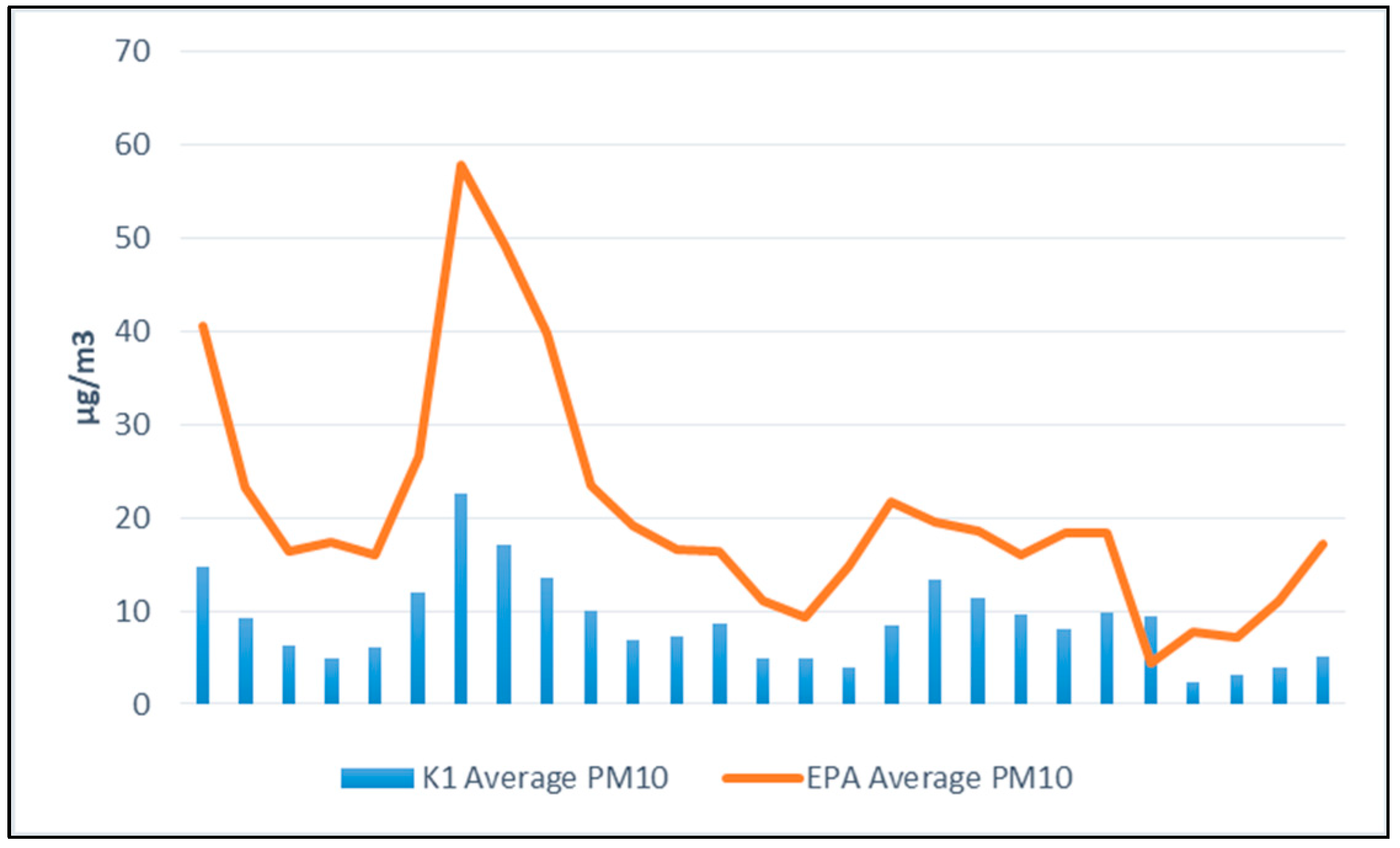
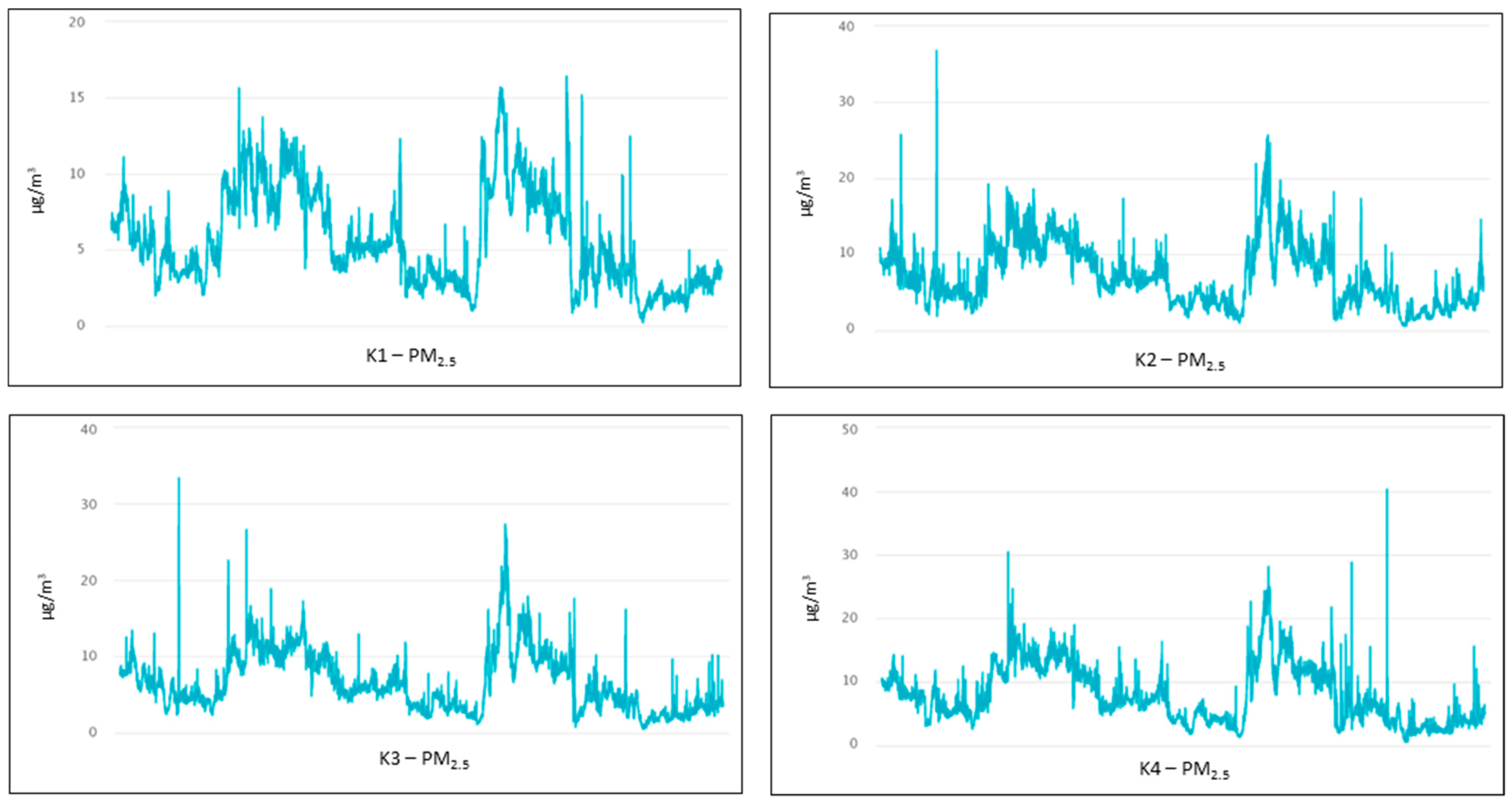
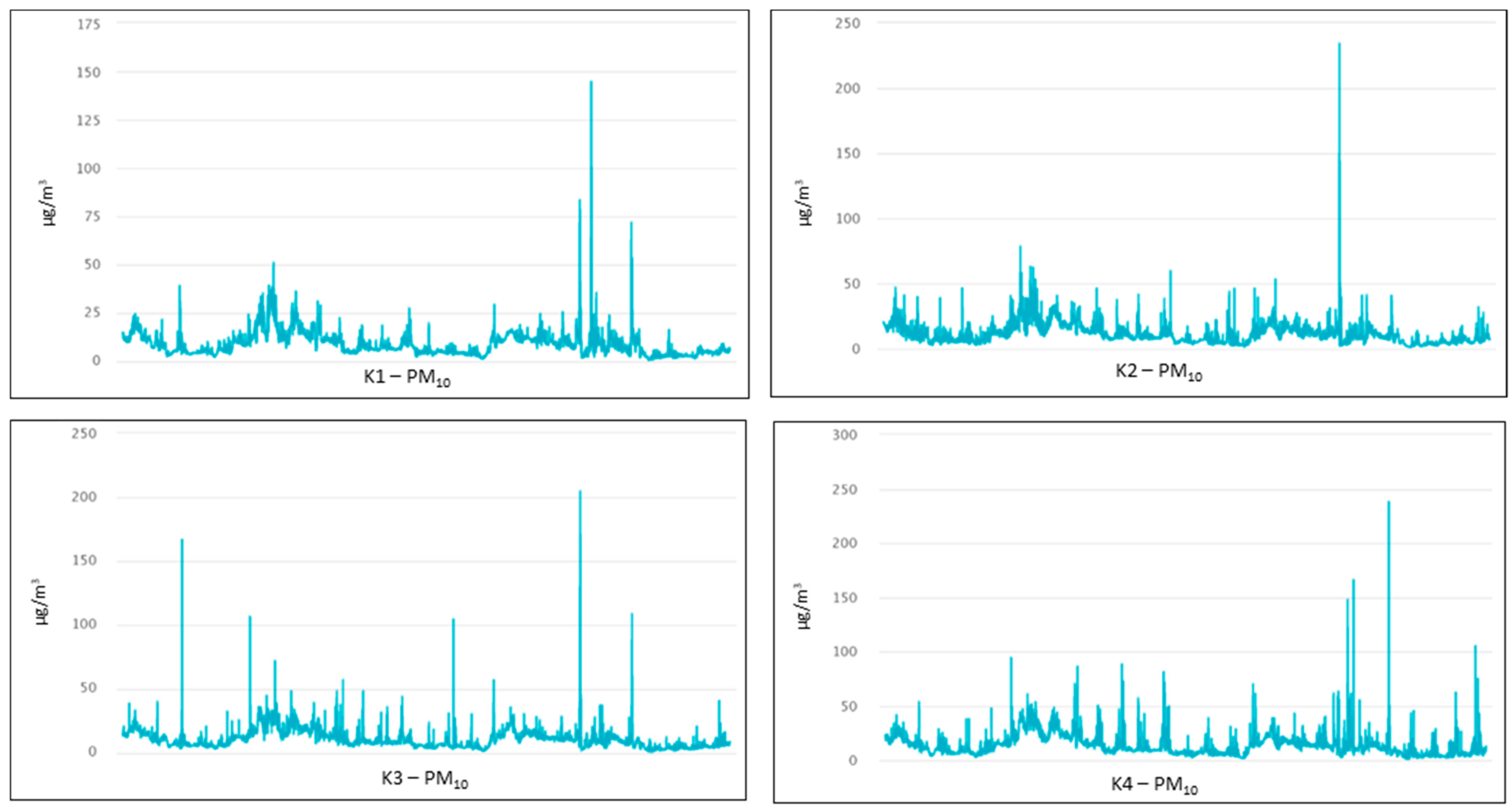
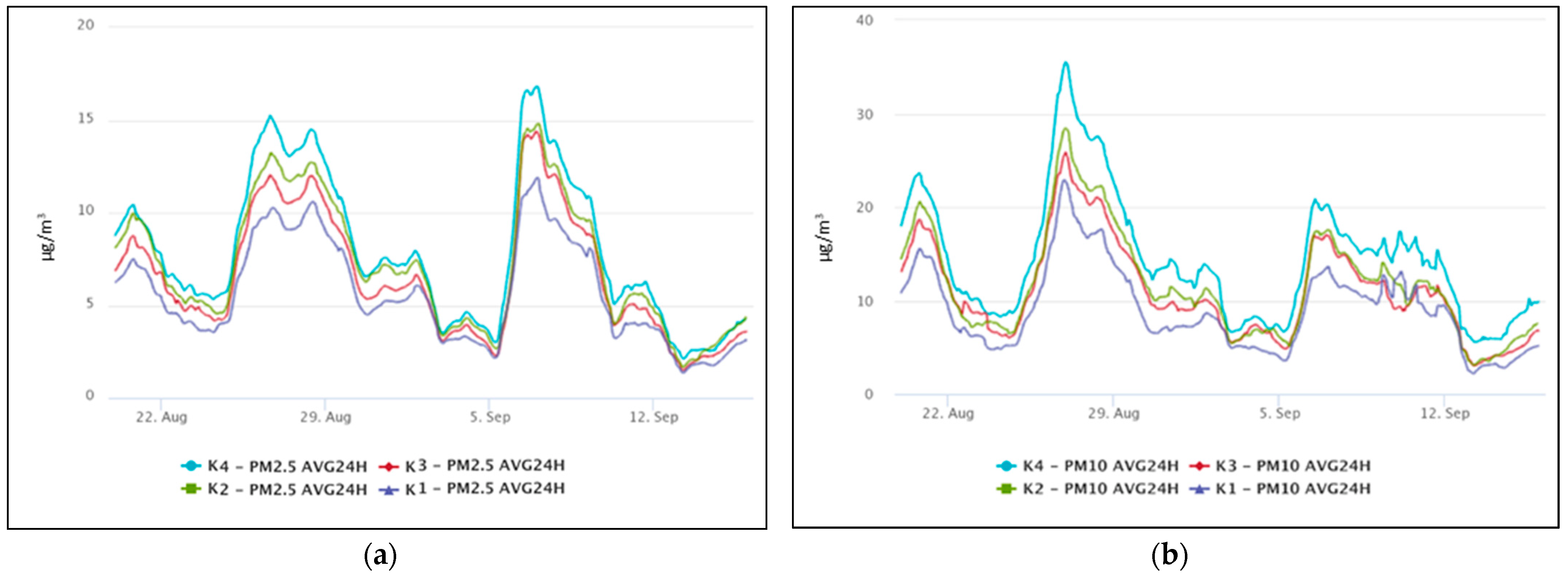
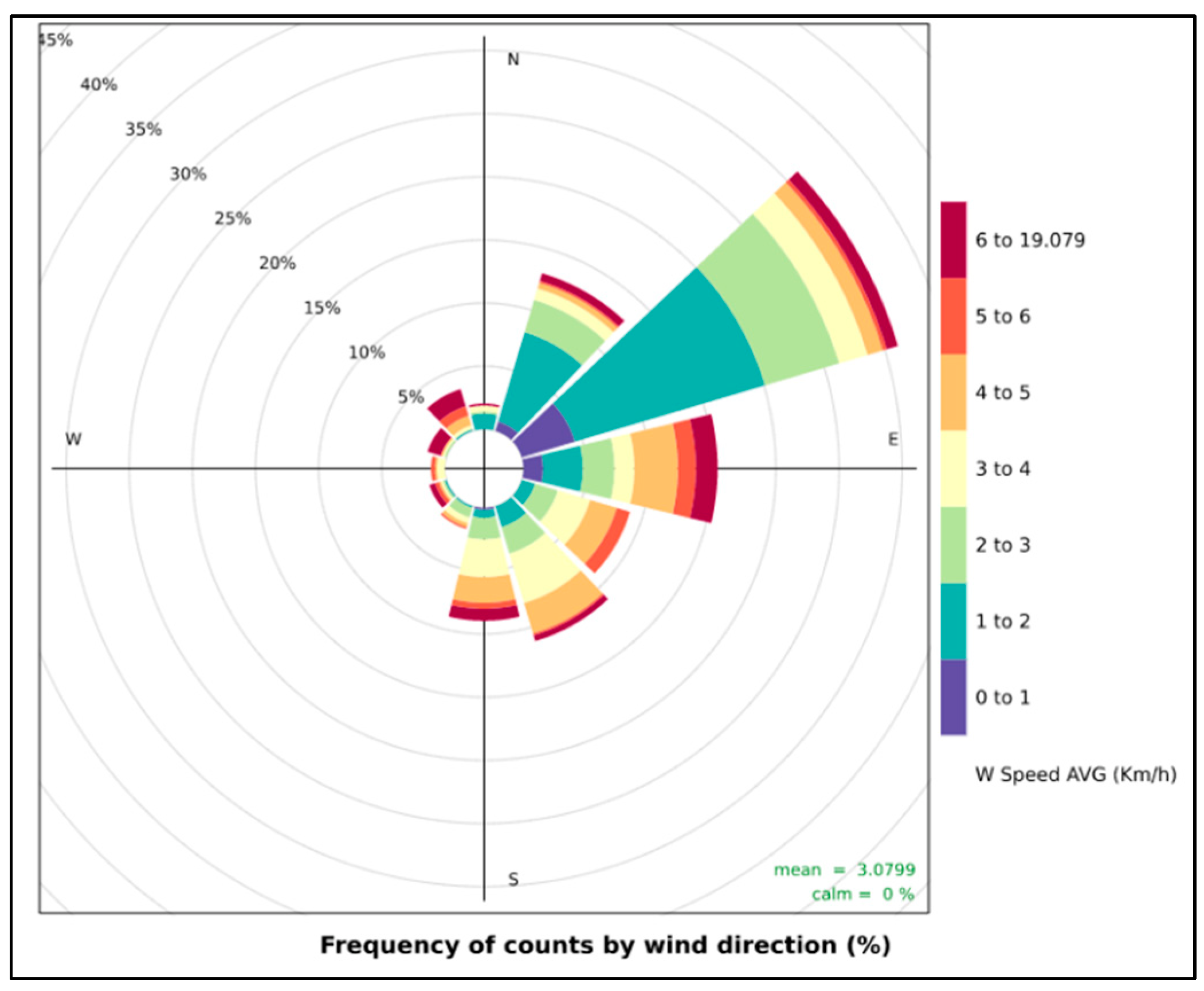
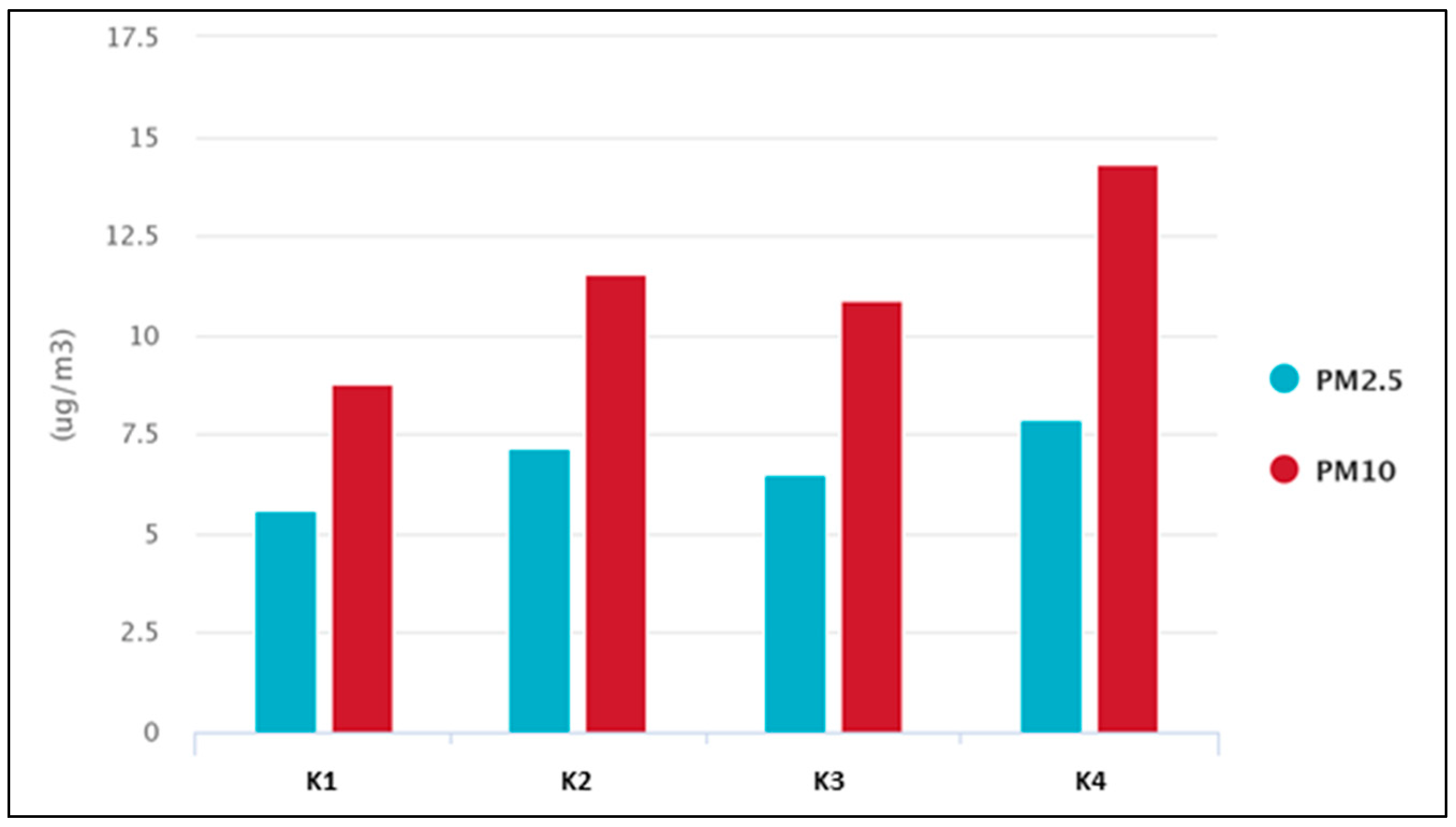
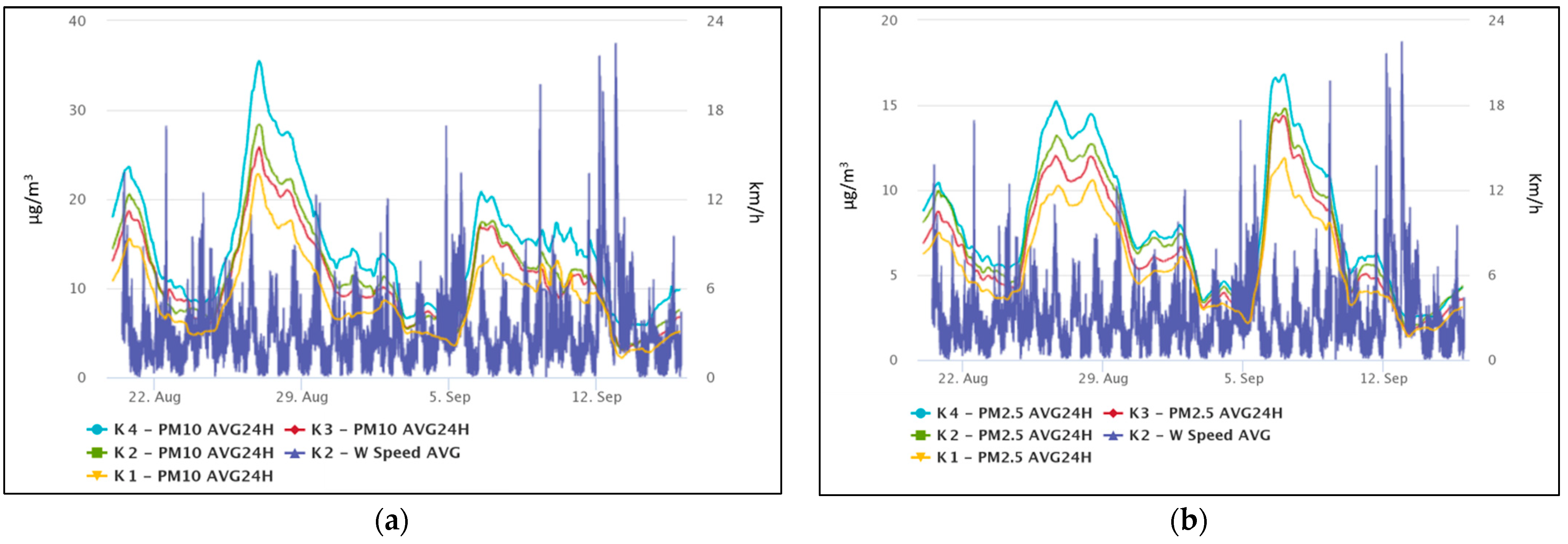
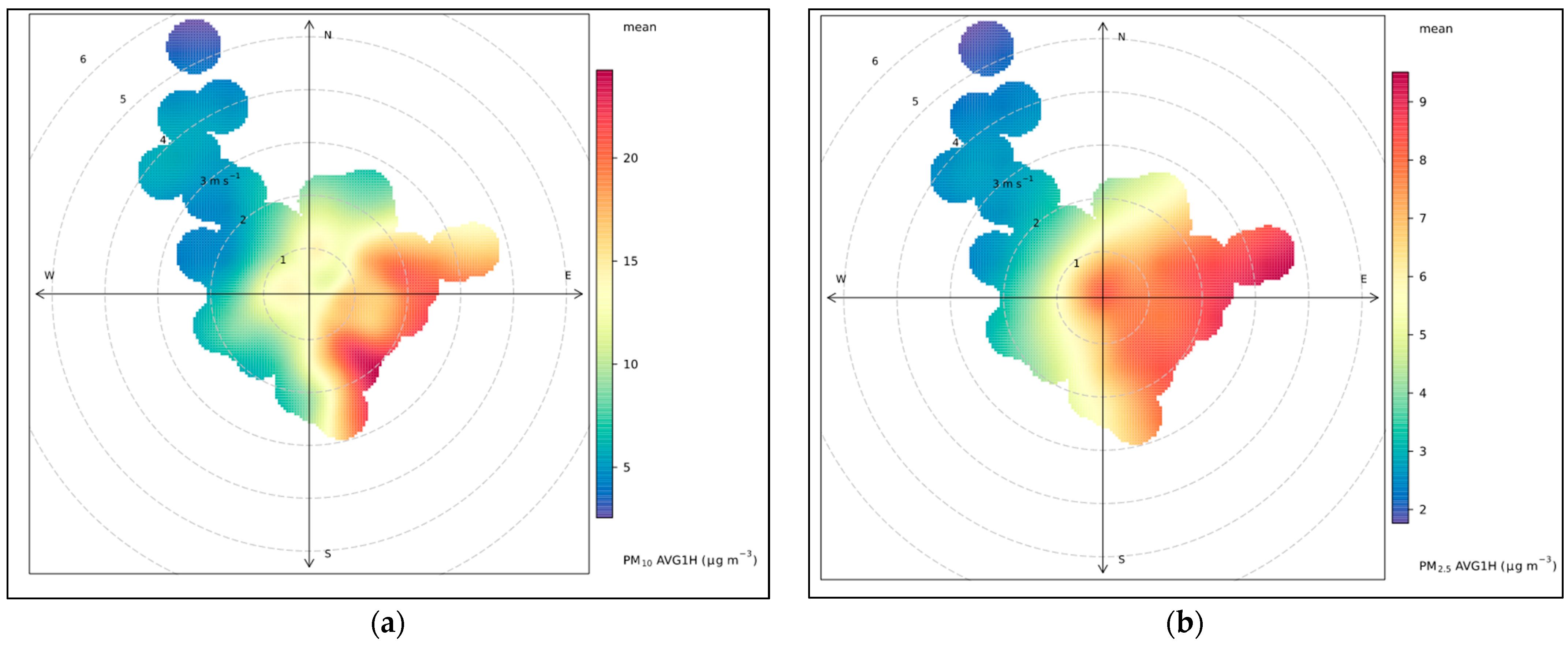
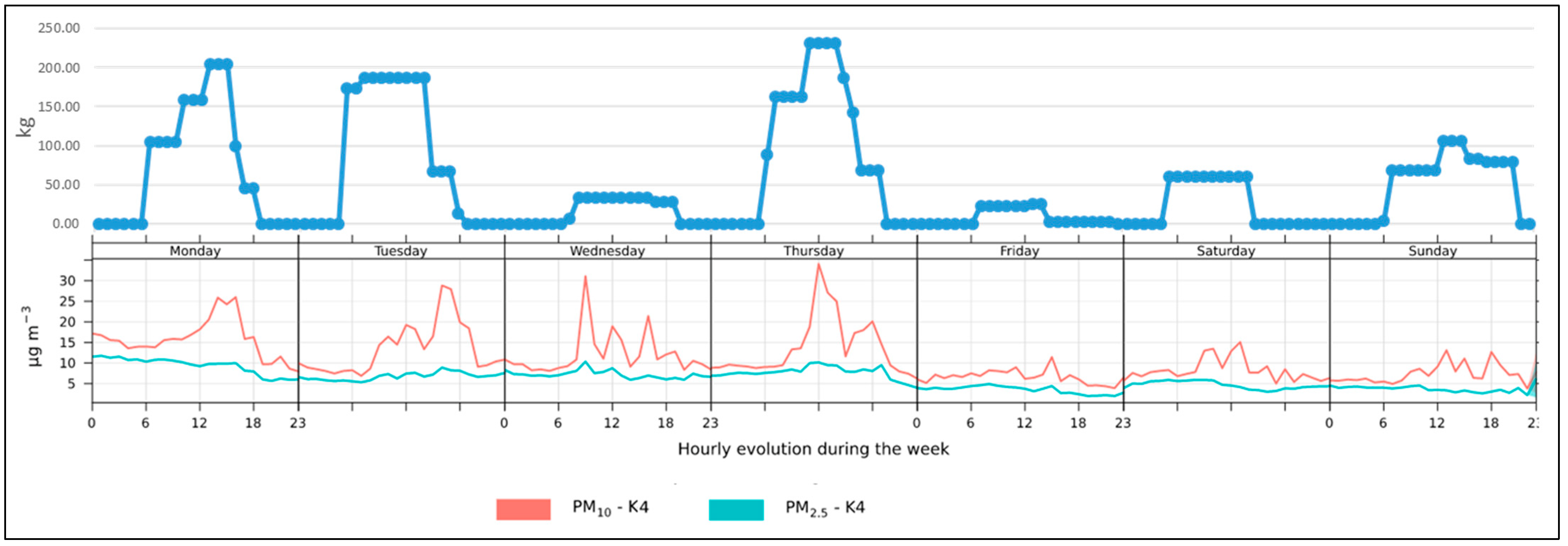
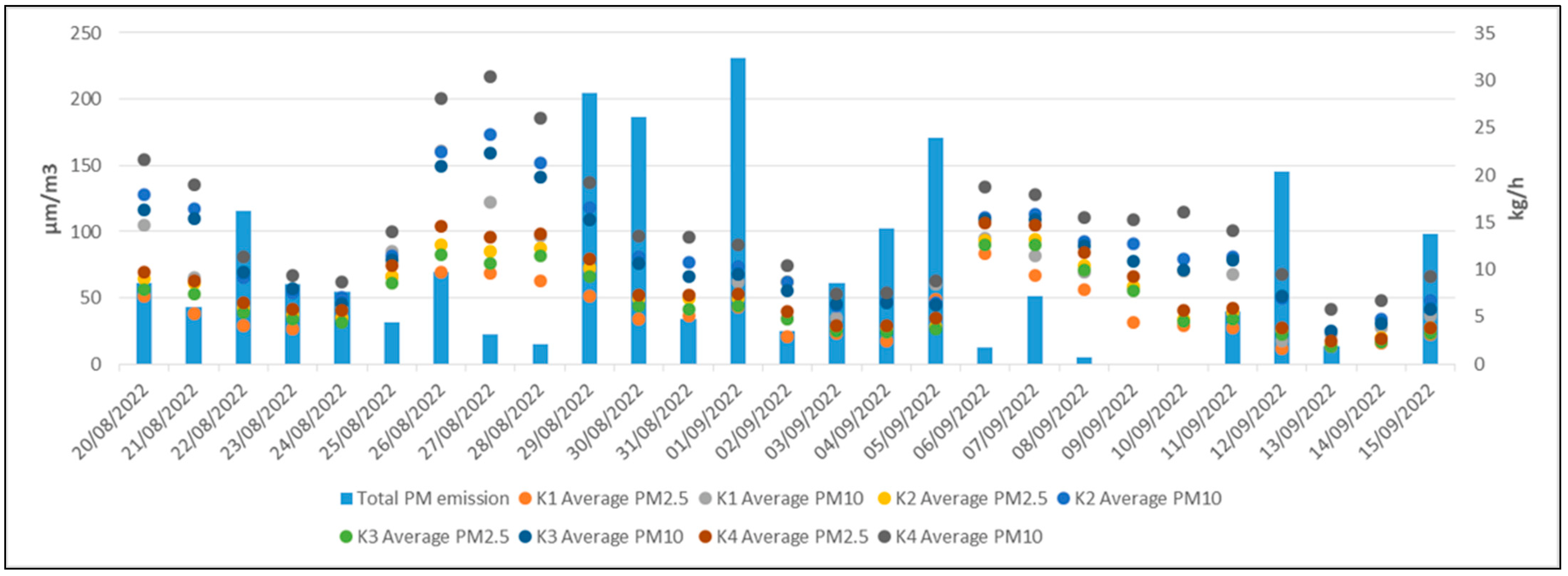
| Cruise Ship Category | Gross Tonnage | Number of Cruise Ships |
|---|---|---|
| Boutique ship | 1000–5000 | 7 |
| Small ship | 5001–50,000 | 10 |
| Mid-size ship | 50,001–101,000 | 9 |
| Large resort ship | >101,001 | 3 |
| Date | Total PM2.5,10 Emitted (kg) | Total BRT | Locations |
|---|---|---|---|
| 20/August/2022 | 60.86 | 90,280 | A1 |
| 21/August/2022 | 42.81 | 170,528 | B, A1 |
| 22/August/2022 | 115.22 | 231,466 | A1, A2 |
| 23/August/2022 | 60.22 | 103,664 | B, A1 |
| 24/August/2022 | 54.97 | 79,442 | B, A1, A2 |
| 25/August/2022 | 31.67 | 34,610 | B, A1 |
| 26/August/2022 | 69.67 | 40,790 | B |
| 27/August/2022 | 22.70 | 14,745 | B |
| 28/Augus/2022 | 15.26 | 65,542 | B |
| 29/August/2022 | 204.27 | 308,986 | A1, A2, A3 |
| 30/August/2022 | 186.72 | 356,964 | B, A1, A2, A3 |
| 31/August/2022 | 33.97 | 34,729 | B, A1 |
| 01/September/2022 | 230.70 | 352,410 | B, A1, A2, A3 |
| 02/September/2022 | 25.09 | 50,098 | B, A1 |
| 03/September/2022 | 60.86 | 90,280 | A1 |
| 04/September/2022 | 102.29 | 87,040 | B, A1, A2 |
| 05/September/2022 | 170.59 | 299,017 | B, A1, A2, A3 |
| 06/September/2022 | 12.65 | 50,795 | B |
| 07/September/2022 | 50.94 | 76,883 | B, A1 |
| 08/September/2022 | 4.99 | 4333 | B |
| 09/September/2022 | 0.00 | 0 | - |
| 10/eptember/2022 | 0.00 | 0 | - |
| 11/September/2022 | 40.00 | 161,370 | B, A1 |
| 12/September/2022 | 145.63 | 231,420 | B, A1, A2 |
| 13/September/2022 | 13.63 | 9976 | B |
| 14/September/2022 | 0.00 | 0 | - |
| 15/September/2022 | 98.28 | 148,302 | B, A1 |
| Total | 1854.01 | 3,093,670 | - |
Publisher’s Note: MDPI stays neutral with regard to jurisdictional claims in published maps and institutional affiliations. |
© 2022 by the authors. Licensee MDPI, Basel, Switzerland. This article is an open access article distributed under the terms and conditions of the Creative Commons Attribution (CC BY) license (https://creativecommons.org/licenses/by/4.0/).
Share and Cite
Gagic, R.; Skuric, M.; Djukanovic, G.; Nikolic, D. Establishing Correlation between Cruise Ship Activities and Ambient PM Concentrations in the Kotor Bay Area Using a Low-Cost Sensor Network. Atmosphere 2022, 13, 1819. https://doi.org/10.3390/atmos13111819
Gagic R, Skuric M, Djukanovic G, Nikolic D. Establishing Correlation between Cruise Ship Activities and Ambient PM Concentrations in the Kotor Bay Area Using a Low-Cost Sensor Network. Atmosphere. 2022; 13(11):1819. https://doi.org/10.3390/atmos13111819
Chicago/Turabian StyleGagic, Radmila, Maja Skuric, Gordana Djukanovic, and Danilo Nikolic. 2022. "Establishing Correlation between Cruise Ship Activities and Ambient PM Concentrations in the Kotor Bay Area Using a Low-Cost Sensor Network" Atmosphere 13, no. 11: 1819. https://doi.org/10.3390/atmos13111819
APA StyleGagic, R., Skuric, M., Djukanovic, G., & Nikolic, D. (2022). Establishing Correlation between Cruise Ship Activities and Ambient PM Concentrations in the Kotor Bay Area Using a Low-Cost Sensor Network. Atmosphere, 13(11), 1819. https://doi.org/10.3390/atmos13111819









